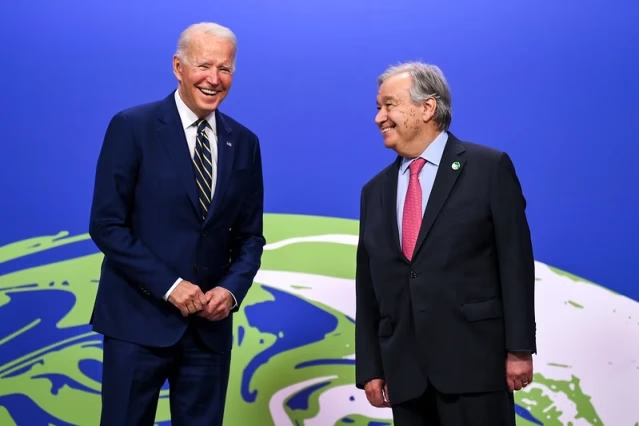The policy framework, the Inflation Reduction Act (IRA), was engineered and passed through Congress by the Biden Administration with cross-party support. It has been hailed as the biggest and most significant policy framework ever approved in the US political system.
As a result, when looking at outgoing President Biden’s climate legacy, this policy alone means that the 46th president’s overall score is high.
But the test of time will demonstrate whether it is strong enough to withstand an incoming Republican administration determined to undo every piece of climate and clean energy legislation.
What counts in favour of the IRA and the Biden Administration is that it has been engineered in such a way that it is mainly benefitting Republican states. This was a piece of genius policy wonkery by Biden’s team, using all their skills to engineer a piece of climate and clean energy policy that a Republican Administration could not completely undo.
Good beginnings
The Biden Presidency started in a ‘we mean business’ mode, in a hurry to undo Trump’s presidential policies and signing a series of executive orders. He cancelled, for good, the long-running saga of the climate and environmentally destructive Keystone XL pipeline and then integrated climate action into every element of government departmental work following another series of executive orders.
A few months later, in a special Earth Day climate summit, Biden announced several new initiatives, including the pledge to halve US emissions by 2030 and increase its UN-focussed nationally determined contributions (NDS).
It did not last
Since then, his climate focus seemed to evaporate slowly, showing a lack of understanding of the climate crisis, moving to approve several controversial fossil fuel projects focusing on lowering the price of petrol. He also engaged in trade-war rhetoric against China, focusing on increased tariffs on clean energy products such as solar panels, which are essential in the clean energy transition.
Biden’s core ideology is rooted in his strong support for trade unions; he often cited climate legislation as creating ‘good-paying union jobs’. However, this underlines a problem in his view on climate action: it is an overall growth strategy and should be connected to union-supported jobs.
This, at times, positioned his climate agenda at odds with his growth strategy to create more jobs, and it became difficult for him to close the door for fossil fuel jobs if they were jobs supported by unions.
The context of US governmental climate policies
This policy should be seen in some context, and it is a struggle any US president trying to address the climate crisis has had to face. Apart from Biden, there has only been one other elected president in the US who tackled the climate crisis as a core element of his agenda, and that was Barack Obama. Therefore, to analyse Biden’s climate agenda, there’s very little to compare with.
To compare who was strongest on climate action between Biden and Obama, the outgoing president probably narrowly clinches the lead, but history will be the true judge.
Historical differences
However, one must underline that the timing of Biden’s presidency coincided with growing evidence of the need to do more about climate change than when Obama was elected. First and foremost, the science to act urgently on climate was even more potent than previously. The global and corporate agenda on climate action was much stronger and fundamentally technological.
Clean energy and clean tech solutions had come such a long way that it was much easier politically and economically for the Biden Administration to scale in the adoption of solar, wind, electric vehicles (EVs) and so on. Additionally, the US public and, crucially, a large portion of the voters who elected Biden demanded that the President undo the damaging policies from the Trump Administration but also significantly scale up climate action to a much stronger baseline than during the Obama Administration.
Strong on policy, not much so on communication
There is no doubt that when it comes to climate and clean energy policies, laws, and initiatives, Biden has accomplished significantly more than Obama. However, Biden, with his increasingly poor speaking skills, often failed to communicate the issue. Across all policy areas, the fact that Biden, towards the end of his tenure, could hardly make a speech or announcement without several gaffes. He struggled to find the words and frequently got key facts wrong, making how he communicated climate action woeful at best. Obama was a much shrewder communicator and gave the impression of understanding climate science at a higher level than Biden.
The missing piece
However, it would be wrong to set the bar between just Biden and Obama, and one should ask what the US President should do or have done, in response to what climate science demands. On this level, Biden woefully failed, and it is no wonder that climate activists and advocates became increasingly frustrated with the lack of willingness and bravery to do more.
The US approach to this was very much directed towards growth and industrial projects. However, as we need to grow clean energy and tech industries, we must also de-grow other industries and encourage societal shifts and consumption habits. We must be educated to drive less, consume less, and make proper investments in collective transport, such as trains and buses and active transport, such as cycling incentives and infrastructure. And there was nothing of this in the Biden tenure – instead, he pledged to lower the price of petrol and energy, which is already far lower than in other developed economies. It does not take much to understand that subsidising energy and petrol is hardly a strong climate agenda.
Hanging on far too late
We called for President Biden to leave the 2024 presidential race, but when he did, it was very late in the campaign, and he gave his vice-president Kamala Harris a mountain to climb. The selfish act of staying in the race so late, even when it was clear that there was no chance that he could beat Donald Trump, greatly enabled the election of Donald Trump. Withdrawing from the race and deciding not to run again could have done much for climate action. This would have given the Democrats a much better chance of beating Trump and, in return, securing a much stronger Biden climate legacy, as all the climate policies he and his team had worked so hard to implement would not face the axe before they had hardly started.
In other areas, his domestic and foreign actions on the war on Gaza also significantly worsened his re-election chances. He drove away many people who felt strongly about this issue, and those people were, in return, also likely to have strong climate views. Many of those had a decisive and influential role in the Democratic Party and chose to either vote for a third-party candidate, such as the Green Party’s Jill Stein, or even abstain.
The fundamental element of Biden’s climate legacy is determined once we know how much will stick. While another withdrawal from the Paris Agreement will face pushback and legal action, with the Republican Party controlling both Congress and the Supreme Court, the only element that stands a chance of surviving in some form is the IRA. Ironically, Republican governors who have significantly benefitted from the IRA could end up being the most prominent allies in protecting some of Biden’s climate legacy.

